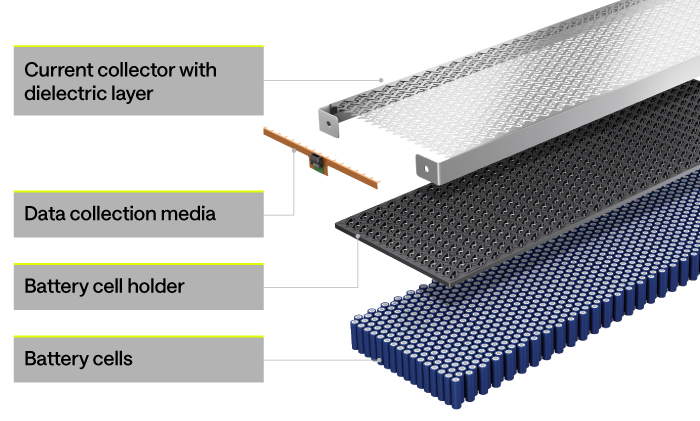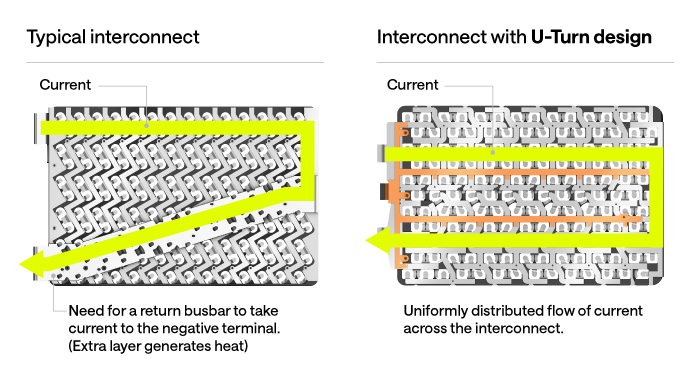Overview
Cell-to-Pack (sometimes referred to as C2P or CTP) is a new battery design approach that eliminates the intermediate modules and connects the battery cells directly to the pack. This reduces the weight, size, and cost of the battery and increases its energy density and efficiency. Another related approach called Cell-to-Chassis (CTC) integrates the cells directly into the EV chassis.

Figure 1 – Cell-to-Pack is a module-less battery pack structure, where cells are assembled directly within the battery pack case.
The Cell-to-Pack idea is driven by benefits from eliminating the material and cabling needed to protect and connect separate modules within the overall battery pack. While modules have been steadily getting larger to support higher power requirements, CTP and CTC take a leap forward by eliminating the modules completely.

Figure 2 – In Cell-to-Chassis, the battery pack is a structural component of the vehicle, where cells are assembled directly into a car’s structure.
Some key advantages of CTP and CTC include:
- Energy Density Improvements: One of the key drivers behind the shift from modular designs to CTP and CTC is the quest for higher energy density. CTP and CTC designs eliminate the need for separate modules and associated components, allowing for more efficient packaging of cells. This can result in a higher energy density and, consequently, a longer driving range for EVs.
- Simplified Manufacturing: CTP and CTC designs streamline the manufacturing process by reducing the number of components and connections. This can lead to cost savings, as well as improved production efficiency. Simplified manufacturing also reduces the risk of defects or failures associated with multiple module connections.
- Reduced Weight: Removing the modules and associated structures can reduce the overall weight of the battery pack. Lighter battery packs can contribute to better vehicle efficiency and performance.
- Thermal Management: Efficient thermal management is crucial for battery health and safety. CTP and CTC designs allow for more effective thermal management systems since the cells are in closer proximity to each other, making it easier to control temperature variations and prevent overheating.
- Space Efficiency: CTP and CTC designs can make better use of the available space within the vehicle chassis. This can free up space for other components, such as passenger or cargo areas, or allow for creative vehicle design options.
- Customization and Scalability: CTP and CTC designs offer more flexibility in designing battery packs for different vehicle models. Manufacturers can easily customize the battery layout and capacity to suit the specific needs of various vehicle types and sizes.
- Recycling and Sustainability: With fewer components and simplified designs, recycling and repurposing of battery materials will become more feasible. This aligns with the growing emphasis on sustainability in the EV industry.
- Safety: CTP and CTC designs can enhance battery safety by minimizing the number of potential failure points and improving overall pack durability.
The shift to CTP and CTC designs also goes hand in hand with the development of advanced battery chemistries, such as solid-state batteries. These chemistries promise higher energy density, faster charging times, and improved safety, making them well-suited for integration into CTP and CTC configurations.
However, the other advantages of CTP and CTC are not dependent on using new battery chemistries. For example, according to battery maker CATL, their CTP 3.0 design can deliver 13% more power by volume using currently available lithium-ion cells, while providing a claimed EV range of 621 miles.
Challenges and Key Enabling Technologies
Among the key implementation challenges with the move to CTP and CTC are the importance of maintaining precision connections between all the cells and the interconnected cell contacting system (CCS) over a much larger physical size. The CCS also must accommodate application-specific CAA to cell interconnect requirements and preferred design approaches for each battery designer and EV manufacturer.

Figure 3 – ENNOVI’s innovative cylindrical cell contacting system, ENNOVI-CellConnect-Round (formerly know as Cell-PLX™).
The ENNOVI-CellConnect-Round is an advanced customizable cell contacting system from ENNOVI. It is a lightweight, ultra-flat, robust current collector approach that helps EV makers overcome the challenges of customizing reliable battery connections for cylindrical Lithium-ion battery cells.
From its inception, the ENNOVI-CellConnect-Round has been designed with the flexibility to adapt to virtually any set of cell contacting system specifications and to provide the extensibility for gracefully accommodating new changes such as the move to CTP and CTC.
ENNOVI-CellConnect-Round has already become the go-to solution for rapid custom design and high-volume manufacturing for a wide range of different customized battery modules by leading battery and EV makers.
Now, our CCS is also leading the way in creating larger, cost-effective, custom Cell-to-Pack and Cell-to-chassis battery designs.
A key to ENNOVI-CellConnect-Round’s successful transition for CTP and CTC lies in the ability of ENNOVI to effectively scale CCS designs to the much larger sizes needed, without any loss of precision flatness and alignment for connecting to the larger number of individual battery cells.
Our CCS designs for CTP and CTC have already been proven to scale effectively from current EV battery modules sizes, such as 300x500mm, with the same precision tolerances maintained for CCS sizes up to over 2 meters long. This provides ample architectural margin to accommodate CTP and CTC projected requirements.
Note: In actual practice, depending on application specifications and shipping considerations, it may be more cost effective for some very large CTP/CTC deployments to use multiple CCS, such as using two 1×2 meter CCS to assemble a 2×2 meter CTP/CTC assembly. In any case, our CCS technology offers ample design headroom to accommodate the full range of projected requirements.
In addition to ENNOVI’s new patented “U-Turn” design options, ENNOVI has further expanded the ENNOVI-CellConnect-Round. This expansion aims to address another critical issue: the tendency of EV batteries to develop hot-spots within the current flow across collector plates. This is an issue that will become even more important with the much larger sizes in CTP and CTC implementations.

Figure 4 – With the U-Turn technology, current density is evenly distributed across the current collector without the need for an additional busbar.
U-Turn technology mitigates internal hot-spots by providing excellent current density spread and uniform distribution of current density throughout the entire battery module. By reducing stress on the individual battery cells, U-Turn enables optimal battery performance and increases EV range.
Summary
As the next phase of EV battery evolution moves toward Cell-to-Pack and Cell-to-Chassis implementations, the opportunities to reduce weight, size, and cost, while dramatically extending EV driving range are enormous.

Figure 5 – The development of battery packaging solutions
However, to achieve these benefits, battery and EV manufacturers need extensible solutions, like ENNOVI-CellConnect-Round, that have already proven reliable in both the design lab and in the field where EVs undergo the ultimate tests.
In this transition to CTC/CTP, amid the highly competitive global EV marketplace, manufacturers cannot afford to take a chance with unproven and untested technologies.
